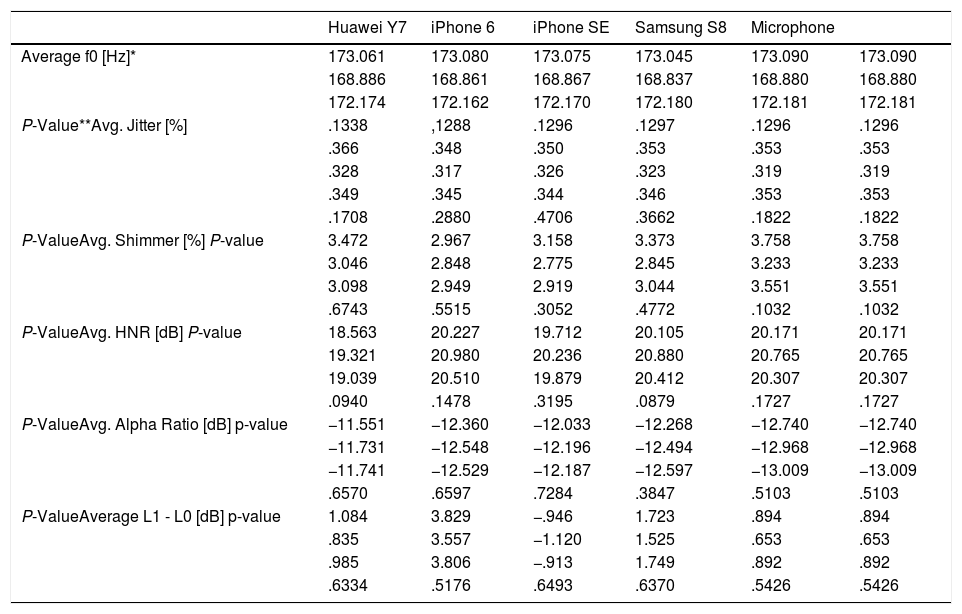Smartphones allow good quality recordings; however, it cannot be claimed that the acoustic parameters obtained from them are comparable to those obtained with a professional microphone. The objective of this study is to establish whether there are significant differences when comparing the values of six acoustic parameters obtained from recordings using four smartphones and a professional microphone.
The Praat programme was used to obtain the acoustic parameters: f0, Jitter, Shimmer, HNR, Alpha Ratio and L1 - L0 of the recording of a sustained vowel /a/ using iPhone SE, iPhone 6, Samsung S8, Huawei Y7 and the Behringer ECM 8000 microphone. The sample was made up of 26 men and 26 women, from 18 to 26 years old without declared voice pathology. The repeated sample ANOVA test was used to compare the values.
All the equipment show reproducibility between consecutive repeated measurements. The parameters f0 and Jitter were the only ones that did not show significant differences between the smartphones and the professional microphone.
None of the smartphones studied can replace the professional microphone in voice recording for the evaluation of the six parameters analysed, except for f0 and Jitter.
Los teléfonos inteligentes permiten obtener grabaciones de buena calidad, sin embargo, no es posible afirmar que los parámetros acústicos obtenidos a partir de ellos sean comparables a los que se pueden obtener con un micrófono profesional. El objetivo de este estudio es determinar si existen diferencias significativas al comparar los valores de seis parámetros acústicos obtenidos a partir de las grabaciones usando cuatro teléfonos inteligentes y un micrófono profesional.
Se usó el programa Praat para obtener los parámetros acústicos: f0, Jitter, Shimmer, Harmonic to noise ratio (HNR), Alpha Ratio y L1 – L0 de la grabación de una vocal sostenida /a/ usando los teléfonos inteligentes: iPhone SE, iPhone 6, Samsung S8, Huawei Y7 y el micrófono Behringer ECM 8000. La muestra la conformaron 26 hombres y 26 mujeres, de 18 a 26 años sin patología vocal declarada. Se uso la prueba ANOVA de muestra repetidas para comparar los valores.
Todos los equipos presentan reproducibilidad entre mediciones repetidas consecutivas. Los parámetros f0 y Jitter, fueron los únicos que no presentaron diferencias significativas entre los teléfonos inteligentes y el micrófono profesional.
Ninguno de los teléfonos inteligentes estudiados puede reemplazar al micrófono profesional en la grabación de la voz para la evaluación de los seis parámetros analizados, excepto para f0 y Jitter.








